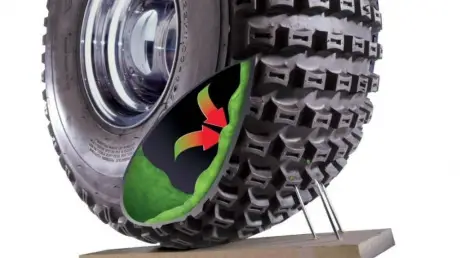
Flat tires or tire punctures are one of the major problems most drivers face every day. It can cause people stress. The process of taking your car to a repair shop or replacing the tire with a temporary tire can dampen your mood.
The most irritating thing is that it can happen anytime. You might have to face flat tires more than one time in the same day. The technological improvements have offered a solution in the form of self-sealing tires to this problem, saving you from all this hassle.
What are self-sealing tires, and how do they work? We will be explaining everything about these tires in this article.
Without further ado, let’s get started.
What Are Self-Sealing tires?
The term self-sealing is evident to some extent, which means that the tire can automatically seal small punctures without needing instantaneous repair. They are pretty similar to run-flat tires technology.
Then the next question is how does self-sealing technology work? The principle behind this technology is to close any leak immediately without any significant loss in the air pressure. To achieve the self-sealing effect, the inner layer of the tire is filled with a thick sticky rubbery substance (liquid). Whenever there is a leak less than or equal to 5 mm, this sticky substance rushes to the location and seals it quickly.
In this way, you can safely keep driving and can go to any repair shop after reaching your destination for the repair.
This revolutionary technology has made the journey and travels easy for people. Now you do not have to be afraid of getting a flat tire. Whether it’s a nail, piece of metal, glass, or another sharp object, nothing can stop you from reaching your destination.
Self-Sealing Technologies:
The self-sealing technologies vary a little from manufacturer to manufacturer. All of them have different guidelines.
- Goodyear’s DuraSeal can seal a puncture up to 0.25 inches.
- Continental’s ContiSeal can seal a hole up to 0.19 (3/16) inches.
- Michelin’s SelfSeal can close a puncture up to 0.25 inches.
- Hankook’s SealGuard can plug a hole up to 0.19 inches.
- Pirelli’s Seal Inside can seal a puncture up to 0.125 inches.
Pros and Cons of Self-Sealing Tires
If you are thinking about buying self-sealing tires, then this section will be pretty interesting for you. Like all other tires, self-sealing tires have pros and cons. Here is a list of them.
Pros of Buying Self-Sealing Tires
The most exciting thing about self-sealing tires is that you do not have to replace the tire whims and can mount them on the normal ones in your use (in most vehicles).
There will be no problem if you want to change your tires separately (one by one). Self-sealing tires work perfectly with standard tires.
Cons of buying Self-Sealing Tires
There are some limitations to the self-sealing ability of the tire. Any puncture on the crown (center area) under 0.25 inches can be sealed quickly. But if the hole is on the shoulder or sidewall, it will not be self-sealed.
Self-sealing tires are a bit expensive when compared to the standard all-season winter and summer tires.
Same articles

Understanding Vehicle Inspection and Verification Services: Why They Matter for Every Driver
GuidesVehicle inspection and verification services are an essential but often overlooked part of keeping roads safe and cars legally compliant. Most people only think about inspections when it’s...
KLIFEX Brand Overview: High-Quality Automotive Repair Kits for Affordable Repairs
GuidesThe automotive aftermarket has long needed solutions that combine reliability, durability, and affordability. Many car enthusiasts and services are looking for a way...
Fast, Reliable Vehicle Emissions & Inspection Services Made Simple
GuidesFast, reliable emissions and inspection services are essential for keeping vehicles road-ready, compliant with environmental regulations, and safe for daily driving. If you’re looking for quick...

